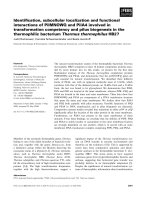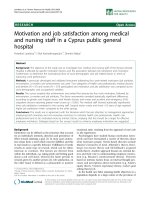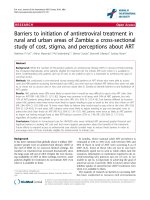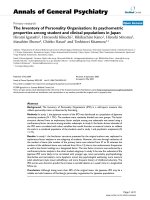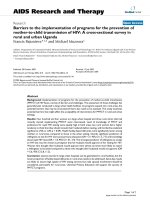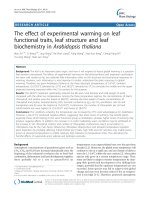Functional status among rural and urban elderly in Ranebennur Taluk, Haveri district, Karnataka, India
Bạn đang xem bản rút gọn của tài liệu. Xem và tải ngay bản đầy đủ của tài liệu tại đây (216.32 KB, 7 trang )
Int.J.Curr.Microbiol.App.Sci (2019) 8(9): 8-14
International Journal of Current Microbiology and Applied Sciences
ISSN: 2319-7706 Volume 8 Number 09 (2019)
Journal homepage:
Original Research Article
/>
Functional Status among Rural and Urban Elderly in Ranebennur Taluk,
Haveri District, Karnataka, India
Aishwarya Koppad* and Vinutha U. Muktamath
Department of Human Development and Family Studies College of Community Science
University of Agricultural Sciences, Dharwad-580005, Karnataka, India
*Corresponding author
ABSTRACT
Keywords
Elderly, Functional status,
Activities of daily living,
Instrumental activities of
daily living, Locality
Article Info
Accepted:
04 August 2019
Available Online:
10 September 2019
The present study aimed to assess the functional status among 180 rural and urban elderly
aged 60 and above during 2018-2019 in Ranebennur Taluk of Haveri district of Karnataka.
A self-structured schedule was used to collect the general information, functional status
was measured by using Katz Index of Independence in Activities of Daily Living (ADL)
and Lawton Instrumental Activities of Daily Living (IADL). The results showed that with
regard to ADL, 41.67 per cent of males functioned fully and only 0.55 per cent had severe
impairment, while 53.33 per cent of females functioned fully, 2.78 per cent had moderate
impairment and 1.67 per cent had severe impairment. Regarding IADL, 16.11 per cent and
26.11 per cent of the male elderly had low and high level of functioning respectively.
Among female elderly 23.89 per cent and 33.89 per cent exhibited low and high level of
functioning respectively. Majority of the rural (96.66%) and urban elderly (93.33%)
belonged to full function category. However, no significant association and difference
between locality and ADL was observed. In rural (67.78%) and urban (52.22%) area most
of the respondents belonged to high category of IADL and a significant association
between IADL and locality was found.
subjects is their functional status. Functional
status is the individual’s ability to live
independently and relate to his/her
environment or perform normal daily
activities for basic needs and carry out normal
functions to maintain health and well‑ being.
According to Knight (2000) functional status
has been used to describe motor function,
ability to perform activities of daily living
(ADL) and the ability to perform instrumental
activities of daily living (IADL). The human
aging is dynamic and progressive, triggering
decline in functional capacity of the elderly.
Introduction
India is a land of most rapidly aging
population (aged 60 and above) in the
developing world. This is due to the
combination of declining birth rates and
increasing life expectancy. Indian elderly
population accounted for 8.60 per cent in 2011
census and is projected to rise to 11.10 per
cent by 2025 (Mahajan and Ray, 2013). The
huge elderly population in India require
multidimensional support and one of the major
determinants of the quality of life of elderly
8
Int.J.Curr.Microbiol.App.Sci (2019) 8(9): 8-14
Activities of daily living refers to a range of
common activities whose performance is
required for personal self-maintenance and
independent community residence like
bathing, dressing, toileting, transferring,
continence and feeding.
pulmonary ventilation. Functional limitation
increases dependency on others for support.
Loss of functional status is associated with
increased risk of institutionalization, stay at
home, hospitalization, need for caregiver and
falls among elderly and is considered as
independent risk factor for mortality (Dolai
and Chakrabarty, 2013). Considering these
facts, the present study was carried out with an
objective to assess the functional status
(activities of daily living and instrumental
activities of daily living) of elderly in urban
and rural areas of Ranebennur Taluk.
Instrumental activities of daily living is
concerned with more complex activities
needed for independent living in a person’s
immediate environment. This type of activities
measure competence in functions that are less
bodily oriented than physical self-maintenance
like using telephone, shopping, food
preparation, housekeeping, laundry, mode of
transportation,
responsibility
for
own
medications and ability to handle finance
(Dolai and Chakrabarty, 2013).
Materials and Methods
Research design
Differential design was used to compare the
functional status among rural and urban
elderly group.
Thus, decline in functional status is measured
by an individual’s loss of independence in
activities of daily living and instrumental
activities of daily living. Threat to functional
independence in elderly arises as a result of
physiological changes from the ageing
process. Functional status is considered, as the
basis of an efficient geriatric assessment,
giving a broad and interdisciplinary approach
to health status. The decline in functional
status may also be associated with a number of
multidimensional factors like biological or
physiological impairment, nutrition, mood,
health status, social relationships, physical
environment
and
the
demographic,
socioeconomic, cultural and psychological
conditions. It is also likely to be influenced by
health perceptions. These factors determine
functional status in older adults.
Locale
The present research study was carried out
exclusively in Ranebennur Taluk of Haveri
district of Karnataka state, India. The city area
and two villages were selected for the study.
Population
The group of elderly from Ranebennur city
and selected villages of Ranebennur Taluka
aged 60 and above formed the population of
study.
Sample
The sample of the study included 180 elderly
(90 from urban and 90 from rural) who were
selected by snow ball technique of sampling.
The elderly population is likely to suffer from
health problems and irreversible decline in
functional abilities. Hypertension, diabetes,
heart attack, stroke, arthritis, cataract etc. are
the major health problems of older adults. It
also includes changes such as reduced muscle
strength, bone density, bladder capacity and
Research tools
The self-structured general information
schedule was used to collect information about
9
Int.J.Curr.Microbiol.App.Sci (2019) 8(9): 8-14
respondents age, gender, locality, religion,
education, type of family, marital status, living
arrangement, working status and health
problems.
The anthropometric measurements of the
respondents were taken by the researcher. The
anthropometric rod to measure height, and
standard weighing machine to assess weight
was used. A single measuring tape was used to
assess the mid upper arm circumference and
calf circumference.
Daily living activities of elderly was assessed
by using Katz Index of Independence in
Activities of Daily Living (ADL) by Katz et
al., (1963). The scale consisted of 6 activities
with 2 statements in each activity. Each
activity has to be answered as ‘independence’
and ‘dependence’ with a score of ‘1’ and ‘0’
respectively. The scale includes activities like
bathing, dressing, toileting, transferring,
continence, and feeding. The score ranges
from 0-6 and is classified into full function (56), moderate impairment (3-4) and severe
functional impairment (0-2).
Data collection
A household survey was conducted and data
collection
tools
were
administered
individually. The elderly were briefed about
the purpose of the study and oral consent was
obtained to conduct the study. The caregiver’s
opinion was also sought in cases wherever
available in order to substantiate the responses
given by the elderly, especially for physical
functioning. It took about 30-40 minutes to
collect the data from each sample.
The independent living skills of elderly was
assessed by using the Lawton Instrumental
Activities of Daily Living (IADL) scale by
Lawton and Brody (1969). It contains 8
categories with 3 to 5 statements in each
category. Each statement has to be answered
as ‘yes’ or ‘no’ with a score of ‘1’ and ‘0’
respectively. The items such as ability to use
telephone, shopping, food preparation,
housekeeping,
laundry,
mode
of
transportation,
responsibility
for
own
medications and ability to handle finance. The
maximum score is 8 and minimum is 0 and the
scores are classified as high (5-8) and low
function (0-4).
Results and Discussion
The demographic characteristics of the sample
selected for the study is presented in the Table
1. In rural area 68.90 per cent belonged to
‘young old’, 20 per cent were ‘old old’ and
11.10 per cent were in ‘oldest old’ category.
The same trend was observed in urban area.
Totally, 76.11 per cent were ‘young old’,
17.22 per cent ‘old old’ and 6.67 per cent
belonged to ‘oldest old’ category.
With regard to gender 43.30 per cent were
males and 56.70 per cent females from rural
area, whereas 41.10 per cent were males and
58.90 per cent were females in urban area.
A pilot study was conducted to test the
reliability of the tools. The reliability for Katz
index of independence in activities of daily
living was found to be 0.87 and for Lawton
instrumental activities of daily living scale
was 0.86.
Majority of the rural (94.40 %) and urban
(96.70 %) subjects were Hindus and only few
were Muslims.
Socio Economic Status (SES) was measured
by Aggarwal et al., (2005) scale and the data
was computed by IBM SPSS Statistics version
21 software.
In rural area 47.78 per cent were illiterates,
41.11 per cent completed higher primary, 10
per cent PUC and only 1.11 per cent were
graduates. In urban area 41.11 per cent were
10
Int.J.Curr.Microbiol.App.Sci (2019) 8(9): 8-14
illiterates, 25.56 per cent completed higher
primary, 8.89 per cent completed PUC and
24.44 per cent were graduates.
subjects were non-working (61.10%). With
regard to socioeconomic status, majority of
the rural (65.60 %) and urban (53.33 %)
families belonged to lower middle class
followed by upper middle (24.40 % Vs 38.89
%) and poor category (10.00 % Vs 7.78 %).
Most of the rural (63.33 %) and urban (72.22
%) subjects reported 1 to 2 health problems
(hypertension and diabetes).
Regarding family type, in rural sample
majority of the respondents (64.40 %) were
from joint family while in urban area most of
them were from nuclear family (53.30%)
system. Majority of the rural (57.78%) and
urban (67.78%) elderly were married.
Table 2 presents that gender wise distribution
of elderly based on their functional status.
With regard to activities of daily living, 41.67
per cent of males fully functioned and only
0.55 per cent had severe impairment, while
53.33 per cent of females fully functioned,
2.78 per cent had moderate impairment and
1.67 per cent had severe impairment. Totally
95 per cent fully functioned, 2.78 per cent had
moderate impairment and 2.22 per cent had
severe level of impairment.
With respect to living arrangement majority of
the subjects (51.10%) were living with spouse
and children followed by living with children
(33.30%), living alone (7.80 %), living with
spouse (5.60%) and only few were living with
others or relatives (2.20%). The same trend
was observed in urban sample.
In rural area most of them (55.60%) were
currently working, while majority of urban
Table.1 Demographic characteristics of the respondents
N=180
Characteristics
Age
Gender
Religion
Education
Type of family
Marital status
Living arrangement
Working status
Socio-Economic Status
Number of health
problems
Category
Young old (60-74 years)
Old old (75-84 years)
Oldest old (≥ 85 years)
Male
Female
Hindu
Muslim
Illiterate
Higher primary
PUC
Graduation and above
Nuclear
Joint
Married
Widow/ widower
With spouse and children
Only with spouse
Only with children
Alone
Others/ Relatives
Working
Non-working
Upper middle (46-60)
Lower middle (31-45)
Poor (16-30)
No health problems
1-2
3-4
Rural (n=90)
62 (68.90)
18 (20.00)
10 (11.10)
39 (43.30)
51 (56.70)
85 (94.40)
5 (5.60)
43 (47.78)
37 (41.11))
9 (10.00)
1 (1.11)
32 (35.60)
58 (64.40)
52 (57.78)
38 (42.22)
46 (51.10)
5 (5.60)
30 (33.30)
7 (7.80)
2 (2.20)
50 (55.60)
40 (44.40)
22 (24.40)
59 (65.60)
9 (10.00)
20 (22.22)
57 (63.33)
13(14.45)
Figures in parenthesis indicate percentages
11
Urban (n=90)
75 (83.33)
13 (14.44)
2 (2.23)
37 (41.10)
53 (58.90)
87 (96.70)
3 (3.30)
37 (41.11)
23 (25.56)
8 (8.89)
22 (24.44)
48 (53.30)
42 (46.70)
61 (67.78)
29 (32.22)
44 (48.90)
17 (18.90)
20 (22.20)
5 (5.60)
4 (4.40)
35 (38.90)
55 (61.10)
35 (38.89)
48 (53.33)
7 (7.78)
11 (12.22)
65 (72.22)
14 (15.56)
Total
137 (76.11)
31 (17.22)
12 (6.67)
76 (42.22)
104 (57.78)
172 (95.55)
8 (4.45)
80 (44.45)
60 (33.33)
17 (9.44)
23 (12.78)
80 (44.44)
100 (55.56)
113 (62.78)
67 (37.22)
90 (50.00)
22 (12.22)
50 (27.78)
12 (6.67)
6 (3.33)
85 (47.22)
95 (52.78)
57 (31.67)
107 (59.44)
16 (8.89)
31 (17.22)
122 (67.78)
27 (15.00)
Int.J.Curr.Microbiol.App.Sci (2019) 8(9): 8-14
Table.2 Gender wise distribution of elderly based on their functional status
N=180
Functional
status
Category
Male
75 (41.67)
1 (0.55)
76 (42.22)
29 (16.11)
47 (26.11)
76 (42.22)
Full function
Moderate impairment
Severe impairment
Total
Low (Dependent)
Instrumental
activities
of High (Independent)
daily living
Total
Activities of
daily living
Gender
Female
96 (53.33)
5 (2.78)
3 (1.67)
104 (57.78)
43 (23.89)
61 (33.89)
104 (57.78)
Total
171 (95.00)
5 (2.78)
4 (2.22)
180 (100)
72 (40.00)
108 (60.00)
180 (100)
Figures in parenthesis indicate percentages
Table.3a Influence of locality on activities of daily living among rural and urban elderly
N=180
Locality
Levels of activities of daily living
Modified Mean ± SD
t-value
Full
Moderate
Severe
²
Total
function impairment impairment
87
1
2
90
1.85NS
5.83 ± 0.93
0.66NS
Rural
(96.70)
(1.10)
(2.20)
(100)
84
4
2
90
5.74 ± 0.85
Urban
(93.33)
(4.44)
(2.23)
(100)
Total
171
5
4
180
5.78 ± 0.89
(95.00)
(2.78)
(2.22)
(100)
Figures in parentheses indicate percentage
NS- Non-Significant
Table.3b Influence of locality on instrumental activities of daily living among rural and urban
elderly
N=180
Locality Levels of instrumental activities of daily living
Mean
±
SD
t-value
²
Low
High
Total
29 (32.20)
61 (67.80)
90 (100)
4.53*
4.95 ± 2.08
0.45NS
Rural
43 (47.80)
47 (52.20)
90 (100)
4.81 ± 2.14
Urban
Total
72 (40.00)
108 (60.00)
180 (100)
4.88 ± 2.11
Figures in parentheses indicate percentage
*Significant at 5 per cent level
NS- Non Significant
Regarding instrumental activities of daily
living 16.11 per cent and 26.11 per cent of the
male subjects had low and high level of
functioning respectively. The 23.89 per cent
and 33.89 per cent of female subjects
exhibited low and high level of functioning.
With respect to total respondents most of the
respondents (60.00 %) revealed high level of
functioning, followed by low level of
functioning (40.00 %).
Table 3a indicates the influence of locality on
activities of daily living of rural and urban
elders. In rural, majority of the respondents
12
Int.J.Curr.Microbiol.App.Sci (2019) 8(9): 8-14
(96.66 %) belonged to full function category
followed by severe impairment (2.23 %) and
moderate impairment (1.11 %). With regard
to urban elderly, majority of the respondents
functioned fully (93.33 %) followed by
moderately impaired (4.44 %) and severely
impaired (2.23 %). However, no significant
association and difference between locality
and activities of daily living was observed.
autonomy and greater interaction with the
environment. The reason may be that women
more independent than men in activities such
as laundry, housekeeping and cooking,
whereas men better in managing traveling and
financial matters independently. These
findings are in line with the study conducted
by Inocian et al., (2014) which indicated that
community
dwelling
elderly
could
independently perform all ADL and IADL
activities. Health related condition was
significant and negatively correlated with
ADL among community elderly in
Philippines. Lazaro-Alquezar et al., (2007)
also quoted same reason that traditionally
women have been more bounded to domestic
work, while men have been bounded to the
administration of money.
Influence of locality on instrumental activities
of daily living is presented in Table 3b. In
rural area most of the respondents belonged to
high category (67.78 %) and 32.22 per cent in
low category. The same trend was observed in
urban area. The ² value revealed significant
association between locality and instrumental
activities of daily living. However, statistical
analysis revealed no significant difference
between locality and instrumental activities of
daily living.
The results of the present study indicated that
(Table 3a and Table 3b) that locality did not
impact on ADL, but significant association
was observed in IADL functioning. Rural
elderly exhibited high functioning in IADL. It
may be due to the factor that IADL activities
are more complex than the ADL activities
which requires only good physical strength.
Also the prevalence of health problems and
non-working condition was high in urban
sample. They spent time with reading, sitting,
watching TV and sleeping longer hours. Rural
elderly were physically active and they were
doing shopping, laundry and food preparation
agriculture work etc. This was line with Wang
et al., (2009) who reported that those who
lived in rural areas of China had the highest
likelihood of maintaining independence in
functional performance than urban elderly.
The present study revealed (Table 2) that
majority of male and female elderly were
functioning fully (95.00 %) and only few
were moderately and severely impaired in
activities of daily living (ADL). The reason
may be that, the daily activities are
fundamental for functioning independently in
life. Hence, these activities are normally
performed by an individual. These scores
were high in young old elderly in comparison
to the old ones. In the study, only few samples
were affected by severe health problems like
stroke, arthritis, severe joint pain, cataract and
kidney problem that lead to dependence in
ADL.
The most of the male and female elderly
(60.00 %) were highly functioning in
instrumental activities of daily living (IADL)
and other were low functioning. The low
functioning in instrumental activities may be
because, these activities are not essential for
fundamental functioning; they are more
complex, require a higher level of personal
So, the family should give more
encouragement to the elderly to come out of
the house and participate in social activities.
Elderly having musculoskeletal problems
should be provided with rehabilitative support
in the community settings. Cities and rural
areas should be made age-friendly like
13
Int.J.Curr.Microbiol.App.Sci (2019) 8(9): 8-14
railings for support in foot path, non-slippery
floor, etc. Geriatric friendly transport services
like low floor buses will help in
accommodating their functional decline.
Katz, S., Ford, A. B., Moskowitz, R. W.,
Jackson, B. A., and Jaffe, M. W. 1963.
Studies of illness in the aged: The index
of ADL: A standardized measure of
biological and psychosocial function.
Int. J. Am. Med. Assoc. 185 (12): 914919.
Knight, M. M., 2000. Cognitive ability and
functional status. J. Advanced Nursing.
31 (6): 1459-1469.
Lawton, M. P., and Brody, E. M. 1969.
Assessment of older people: Selfmaintaining and instrumental activities
of daily living. The Gerontologist. 9 (3):
179-186.
Lazaro-Alquezar, A., Rubio Aranda, E.,
Sanchez Sanchez, A., and Garcia
Herrero, J. C. 2007. Functional capacity
for daily living activities among senior
citizens attending community centers in
the city of Zaragoza, Spain. Rev. Esp.
Salud. Publica. 81: 625-636.
Mahajan, A., and Ray, A. 2013. The Indian
elder: Factors affecting geriatric care in
India. Glob. J. Med. Public Health. 2: 15.
Wang, D., Zheng, J., Kurosawa, M., Inaba,
Y., and Kato, N. 2009. Changes in
activities of daily living (ADL) among
elderly Chinese by marital status, living
arrangement and availability of health
care over a 3-year period. Environ.
Health Prev. Med. 14 (1): 128-141.
Acknowledgement
The research paper is a part of masteral
research conducted under the aegis of
University
of
Agricultural
Sciences,
Dharwad. So, I acknowledge University of
Agricultural Sciences, Dharwad for the
support and rural and urban elderly from
Ranebennur Taluk, Haveri district, Karnataka.
References
Aggarwal, O. P., Bhasin, S. K., Sharma, A.
K., Chhabra, P., Aggarwal, K., and
Rajoura, O. P. 2005. A new instrument
(scale) for measuring the socioeconomic status of a family:
Preliminary study. Indian J. Comm.
Med. 34 (4): 111-114.
Dolai, M. C., and Chakrabarty, F. 2013.
Functional status of the elderly Santal
people. Int. J. Humanities and Soc. Sci.
Invention. 2 (1): 1-6.
Inocian, E. P., Inocian, E. P., and Ysatam, E.
I. 2014. The dependency needs in the
activities of daily living performance
among Filipino elderly. Int. Res. J. Med.
Med. Sci. 2 (2): 44-50.
How to cite this article:
Aishwarya Koppad and Vinutha U. Muktamath. 2019. Functional Status among Rural and
Urban
Elderly in
Ranebennur
Taluk,
Haveri
District,
Karnataka,
India.
Int.J.Curr.Microbiol.App.Sci. 8(09): 8-14. doi: />
14

